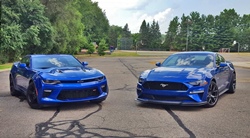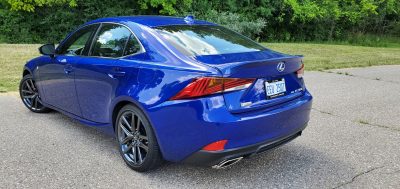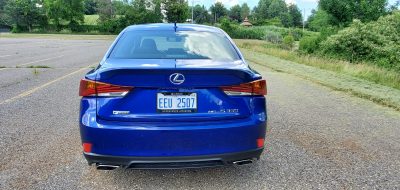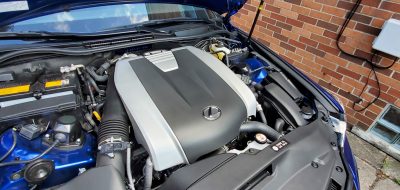When Lexus took the veil off of the 2021 Lexus IS, it certainly appeared to be a noticeable improvement over the outgoing model which was really starting to show its age, and was falling behind rivals in a number of categories. But what can buyers expect in terms of changes, and is the new model indeed better than the outgoing IS? To find out, we spent some time behind the wheel of a 2020 model, and it certainly answered alot of our burning questions.
Fresh Styling Rules The Day:
One of the most obvious changes that buyers will notice is with the exterior styling itself. The outgoing model was quite literally a very busy canvas, with splashes of curves, hard angles, and odd designs mixing with the front spindle grille to create a very dynamic canvas that has certainly not aged well with the passage of time. In contrast, the 2021 model brings some much needed order to the chaos, and arrives with a much more polished presentation. The headlights are much sharper looking than before, and the spindle grille does a better job of formally meshing with the look that Lexus designers were trying to achieve. The side profile is also smoother and when compared to the old model, it manages to add more splashes of elegance to the design than ever before. The rear of the car also sees its fair share of changes, and like before, they aim to bring unity and simplicity to the design. Instead of the hard angled tailights of yore, the 2021 model features a unified light bar, with the angles being reworked for a more aggressive yet elegant appearance.
With the BMW 3-Series, Mercedes C-Class, and the Audi A4 all receiving refreshes over the past few years, it was only a matter of time before the Lexus IS would follow suit. It will be a matter of time before the 2021 IS makes its way to dealerships, but buyers will certainly have plenty to look forward to, especially when the new look is paired with the right paint color.
Mixture of old and new elements highlights the cabin:
Unlike the changes that were done with the exterior, the basic DNA of the interior is largely unchanged, but Lexus designers still made an effort at sprucing things up for the new model year. The central rectangular vents were retained, but the rest of the square-ish openings have been pitched for new round units. Lexus also added a new design for the stop/start button, and has finally replaced the dated and frustrating mouse style controller for the infotainment system, and has replaced it with an updated touch pad setup. As mentioned in our other encounters with the touchpad, it still does not solve some of the core problems with the system, but it is a welcome step in the right direction. Lexus will also offer a few new colors and appearance packages to help spruce things up further, but buyers looking for an outright evolution will have to wait a bit longer for that to happen.
However, buyers that were hoping to see some major changes to the technology front will be pleasantly surprised with what they see. A major addition for 2021 is the welcome addition of an all new touchscreen to the IS. Before the new IS appeared, its predecessor was one of the last stalwarts in its segment to resist the transition to a formal touchscreen unit, with the car being equipped with a small 7-inch display screen. The new system uses a larger 8-inch display that has been moved three inches closer to occupants.
A larger 10.30 inch screen is also available, with both screens featuring built-in Apple CarPlay and Android Auto capability. This is another welcome change, and that should please buyers that aim to have higher levels of connectivity with their mobile devices. It will be interesting to see how the system measures up in the real world against rivals like BMW’s iDrive, but if the Alexa part of the equation is fully integrated into the system, it would allow drivers to have full access to all the standard features that Alexa brings to the table including the ability to make phone calls, operate the climate control system, etc.
Familiar Performance:
Engine options for the 2021 Is are carried over from the outgoing one, with a 2.0 liter 241 horsepower turbocharged four cylinder serving as the base engine. The IS 350 is still motivated by the naturally aspirated 3.5 liter V6 that’s good for 311 horsepower. Our 2020 tester came equipped with this particular engine, and while it still delivers some of the commendable muscle that we have come to enjoy out of this particular powerplant. It also serves as a compelling window into the age of the performance hardware. Many of the higher tier engine options in the IS’s segment have embraced turbocharging, and the naturally aspirated V6 is a stubborn leftover from a different era in luxury when cylinder count and displacement were considered very important.
All of this muscle is still routed through a pair of automatic transmissions. While the four cylinder model is available with the eight speed only, the more powerful IS 350 has two transmissions depending on what drive layout is chosen. Rear wheel drive models get the fore-mentioned eight speed, but all-wheel drive models continue to use a six speed automatic.
Our 2020 example came with the latter setup, and it did a good job delivering smooth shifts, as well as the response needed for spirited driving. The sprint to 60 mph is covered in 5.7 seconds, which is carried over to the 2021 model. On that note, the 2021 version restricts the F-Sport package to 350 models only, but the package itself has been reworked to be better than ever. The adaptive suspension has been tweaked to deliver better handling behavior, while an all new “Dynamic Handling Package” helps shave 16 pounds from the IS thanks to lighter wheels. We will have to wait until we get a chance to go behind the wheel of the 2021 version to see if these changes make a noticeable difference, but with the 2020 model already doing a good job delivering solid driving dynamics, we suspect that the changes will only be noticed by discerning drivers.
Value Quotient:
Lexus still has not released pricing for the 2021 IS as of this writing, but the pricing ladder for the 2020 model could serve as a rough guide for what to expect considering that we think the ladder will not change too radically much for 2021 save for the restrictions regarding F-Sport availability for certain models. A base 2020 IS starts at $38,560, with that price getting you a rear wheel drive equipped IS 300 with the four cylinder. Step up to the IS 350, and you are greeted with a base price of $42,180, with F-Sport model raising that figure slightly to $45,375 for rear wheel drive. Adding all-wheel drive like our test car’s will cost you $46,710 which is roughly in the same side of the pool as other rivals from BMW and Audi.
Our tester arrived with a whole host of options, which helped push the final price tag to $53,599 with the $1,025 destination fee included. That’s a steep price to pay, especially when you consider that the IS in its current form is an aging platform that’s missing key equipment, and some of the luxury features that many buyers often take for granted. However, the IS is also a unique personality of a car, and in certain situations, it can reward the driver with a commendable amount of driving fun.
That said, we cannot wait for the 2021 IS to arrive in dealer showrooms. The model is a welcome update over the outgoing IS, and it also manages to solve some of the quirks that cause the IS to fall behind benchmarks like the BMW 3-Series. While we wish that Lexus could’ve made more extensive changes to the performance hardware, we look forward to trying out the new infotainment system, as well as seeing what the Dynamic Handling Package brings to the table.

Carl Malek has been an automotive journalist for over 10 years. First starting out as a freelance photographer before making the transition to writing during college, his work has appeared on numerous automotive forums as well as websites such as Autoshopper.com.
Carl is also a big fan of British vehicles with the bulk of his devotion going to the Morgan Motor Company as well as offerings from Lotus, MG, and Caterham. When he is not writing about automobiles, Carl enjoys spending time with his family and friends in the Metro Detroit area, as well as spending time with his adorable pets.




















































